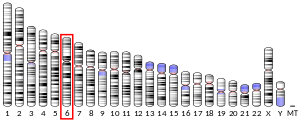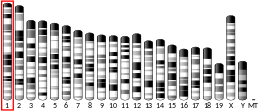CRISP1
Cysteine-rich secretory protein 1 is a cysteine-rich secretory protein that in humans is encoded by the CRISP1 gene.[5][6]
Fertilization consists of a sequence of specific cell-cell interactions culminating in the fusion of the sperm and egg plasma membranes. Recognition, binding, and fusion occur through the interaction of complementary molecules that are localized to specific domains of the sperm and egg plasma membranes. In the sperm, the postacrosomal region or equatorial segment is involved in sperm-egg plasma membrane fusion. The protein encoded by this gene is a member of the cysteine-rich secretory protein (CRISP) family. This protein is expressed in the epididymis, is secreted into the epididymal lumen, and binds to the postacrosomal region of the sperm head where it plays a role at fertilization in sperm-egg fusion through complementary sites localized on the egg surface. Two isoforms are encoded by transcript variants of this gene.[6]
References
- GRCh38: Ensembl release 89: ENSG00000124812 - Ensembl, May 2017
- GRCm38: Ensembl release 89: ENSMUSG00000025774 - Ensembl, May 2017
- "Human PubMed Reference:". National Center for Biotechnology Information, U.S. National Library of Medicine.
- "Mouse PubMed Reference:". National Center for Biotechnology Information, U.S. National Library of Medicine.
- Hayashi M, Fujimoto S, Takano H, Ushiki T, Abe K, Ishikura H, Yoshida MC, Kirchhoff C, Ishibashi T, Kasahara M (Feb 1997). "Characterization of a human glycoprotein with a potential role in sperm-egg fusion: cDNA cloning, immunohistochemical localization, and chromosomal assignment of the gene (AEGL1)". Genomics. 32 (3): 367–74. doi:10.1006/geno.1996.0131. PMID 8838800.
- "Entrez Gene: CRISP1 cysteine-rich secretory protein 1".
External links
- Human CRISP1 genome location and CRISP1 gene details page in the UCSC Genome Browser.
Further reading
- Kirchhoff C (1998). "Molecular characterization of epididymal proteins". Rev. Reprod. 3 (2): 86–95. doi:10.1530/ror.0.0030086. PMID 9685187.
- Cuasnicú PS, Ellerman DA, Cohen DJ, et al. (2002). "Molecular mechanisms involved in mammalian gamete fusion". Arch. Med. Res. 32 (6): 614–8. doi:10.1016/S0188-4409(01)00321-6. PMID 11750738.
- Evans JP (2003). "The molecular basis of sperm-oocyte membrane interactions during mammalian fertilization". Hum. Reprod. Update. 8 (4): 297–311. doi:10.1093/humupd/8.4.297. PMID 12206465.
- Hayashi M (1996). "[Analysis of the human acidic epididymal glycoprotein-like molecule: isolation of cDNA and tissue localization]". Hokkaido Igaku Zasshi. 70 (5): 743–53. PMID 8543280.
- Krätzschmar J, Haendler B, Eberspaecher U, et al. (1996). "The human cysteine-rich secretory protein (CRISP) family. Primary structure and tissue distribution of CRISP-1, CRISP-2 and CRISP-3". Eur. J. Biochem. 236 (3): 827–36. doi:10.1111/j.1432-1033.1996.t01-1-00827.x. PMID 8665901.
- Cohen DJ, Ellerman DA, Busso D, et al. (2001). "Evidence that human epididymal protein ARP plays a role in gamete fusion through complementary sites on the surface of the human egg". Biol. Reprod. 65 (4): 1000–5. doi:10.1095/biolreprod65.4.1000. PMID 11566719.
- Strausberg RL, Feingold EA, Grouse LH, et al. (2003). "Generation and initial analysis of more than 15,000 full-length human and mouse cDNA sequences". Proc. Natl. Acad. Sci. U.S.A. 99 (26): 16899–903. doi:10.1073/pnas.242603899. PMC 139241. PMID 12477932.
- Mungall AJ, Palmer SA, Sims SK, et al. (2003). "The DNA sequence and analysis of human chromosome 6". Nature. 425 (6960): 805–11. doi:10.1038/nature02055. PMID 14574404.





